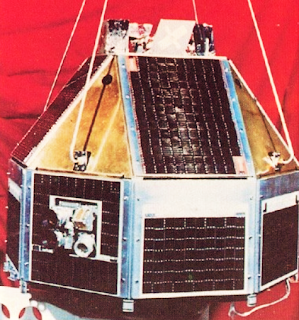 The main objective of launching satellites of the Rohini series by
India was to test the country's first satellite launch vehicle SLV-3 and launch
4 satellites of 30 to 40 kilograms of the series, by launching this vehicle to
check the actual capacity of its rockets because these vehicles were being seen
as the cornerstone of the construction of future rockets of the country.
The main objective of launching satellites of the Rohini series by
India was to test the country's first satellite launch vehicle SLV-3 and launch
4 satellites of 30 to 40 kilograms of the series, by launching this vehicle to
check the actual capacity of its rockets because these vehicles were being seen
as the cornerstone of the construction of future rockets of the country.Although only two of the four planets that were launched under this series succeeded, but this proved to be an interim halt for the development of small launch vehicles of the country. After this, the Indian space program entered a new era of development where the journey of development of Satellite launch vehicles and Polar satellite launch vehicles began.
Launch of Rohini: First Experimental flight
The first experimental flight of SLV-3 with "Rohini" satellite took place on
Sriharikota launch site on August 10, 1969, but it could not be successful due
to the failure of control system of the second segment of the vehicle, it
got destroyed and fell into the Bay of Bengal immediately after the launch, the
Rohini satellite placed on it was also destroyed.
Successful launch of Rohini RS-1: Second Experimental Flight
 On July 18, 1980, the second flight of the SLV-3 took place at 8:04 am from
Sriharikota launch site and it was successful as it made some basic amendments,
along with removing the responsive shortcomings for the failure of the first
experimental flight. With the successful flight of this vehicle, the
satellite RS-1 of Rohini series was successfully launched.
On July 18, 1980, the second flight of the SLV-3 took place at 8:04 am from
Sriharikota launch site and it was successful as it made some basic amendments,
along with removing the responsive shortcomings for the failure of the first
experimental flight. With the successful flight of this vehicle, the
satellite RS-1 of Rohini series was successfully launched.It is known that despite successful launch, the RS-1 could not be installed in its fixed class and its minimum distance from Earth was 276 kilometers instead of 308 kilometers and the maximum distance was 472 kilometers instead of 910 kilometers. Because of this, its period had been changed to 1 year instead of pre-determined 7 days and it remained efficient in its class till 23 July 1981.
It is of course that the historic success of its successful launch has given the Indian space program a new direction. India became the sixth country in the world with indigenous technology and developed launch vehicle, in which Soviet Union, United States, France, Japan and China are already included.
Launch of Rohini RS-D1: Third
Experimental Flight
 On May 31, 1981, the third flight of
satellite launch vehicle SLV-3 at Sriharikota satellite launch site, which was
its first developmental flight, proved to be unsuccessful in establishing
RS-D1, the third satellite of the Rohini series in the fixed
class. Although this vehicle successfully launched Rohini RS-D1, it could
not be delivered to the fixed class.
On May 31, 1981, the third flight of
satellite launch vehicle SLV-3 at Sriharikota satellite launch site, which was
its first developmental flight, proved to be unsuccessful in establishing
RS-D1, the third satellite of the Rohini series in the fixed
class. Although this vehicle successfully launched Rohini RS-D1, it could
not be delivered to the fixed class.
The result was that the planet was
destroyed in only one week despite the designated age limit of 300 days.
Successful Launch of Rohini RS-D2: Fourth Experimental Flight
 About two years after the unfortunate
failure of Rohini RS-D1, on April 17, 1983, SLV-3 rocket was successfully
launched with the fourth of the Rohini series and country's eighth satellite
Rohini RS-D2. This 41.5 kilograms satellite was installed in its fixed
class and this success proved SLV-3 to be an authentic launch vehicle.
About two years after the unfortunate
failure of Rohini RS-D1, on April 17, 1983, SLV-3 rocket was successfully
launched with the fourth of the Rohini series and country's eighth satellite
Rohini RS-D2. This 41.5 kilograms satellite was installed in its fixed
class and this success proved SLV-3 to be an authentic launch vehicle.
The most important thing about this
satellite was that it included a solid-state camera of two bands called
"Smart Sensor" for the purpose of photographing various parts of the
earth during the orbiting by exploring the conditions of crops, water, fallow
land, cloud, ice etc. which successfully performed the task.
Will be Continued>>
Further read-











0 Comment Here:
Post a Comment
Share your Feedback